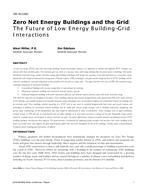Description
As zero net energy (ZNE) and other low-energy buildings become increasingly common, it is important to consider how different ZNE strategies can
interact with local electricity grids. The electricity grid was built as a one-way street, with energy flowing from the power plant to buildings. But widely
distributed renewable energy systems and other cutting-edge building technologies will change that equation as the grid transitions to a transactive energy
framework with integrated demand-side management. Demand response (DR) technologies and grid-sensitive design features in ZNE buildings will be
critical to enabling the successful integration of these facilities into the grid at a large scale. The paper describes three tiers of DR and renewable energy
technology integration in commercial buildings:
1. Conventional buildings with one-way energy flows or conventional net metering
2. Moderately responsive buildings with interactive demand response capacity
3. Fully grid-integrated buildings with active and passive efficiency and demand response features, often with onsite renewable energy
This third tier represents the buildings of the future. These buildings integrate grid-sensitive design features, fully dispatchable DR across major end-uses
in the building, and carefully designed and installed renewable energy technologies that are intended to improve the relationship between the building and
the electricity grid. These buildings, whether operating at a ZNE level or not, must be explicitly designed with both active and passive features and
technologies to optimize the interactions between buildings and the utility grid. Passive design strategies such as building orientation, daylighting, and
passive space conditioning, are the foundational step and should be implemented as much as practicable. Active strategies such as night ventilation,
thermal storage, or DR will also be instrumental and can allow buildings to be used when necessary as storage for the grid. Renewable energy systems
should be carefully chosen and designed to interact well with the grid. The paper differentiates between renewable-oriented and efficiency-oriented ZNE
building typologies and discusses their impacts. The paper presents a framework for employing design strategies and measures that ensure buildings of the
future can benefit from, and support, the grid modernization efforts that will occur throughout the life of the buildings. Finally, policy recommendations
to improve future building-grid interactions are offered.
Citation: 2016 Winter Conference, Orlando, FL, Conference Papers
Product Details
- Published:
- 2016
- Number of Pages:
- 8
- Units of Measure:
- Dual
- File Size:
- 1 file , 910 KB
- Product Code(s):
- D-OR-16-C083




